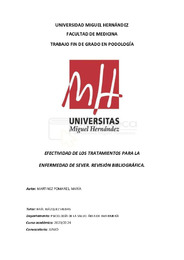Please use this identifier to cite or link to this item:
https://hdl.handle.net/11000/33319Full metadata record
| DC Field | Value | Language |
|---|---|---|
| dc.contributor.advisor | Blázquez Viudas, Raúl | - |
| dc.contributor.author | Martínez Pomares, María | - |
| dc.contributor.other | Departamentos de la UMH::Ciencias del Comportamiento y salud | es_ES |
| dc.date.accessioned | 2024-09-27T12:16:51Z | - |
| dc.date.available | 2024-09-27T12:16:51Z | - |
| dc.date.created | 2024-06-30 | - |
| dc.identifier.uri | https://hdl.handle.net/11000/33319 | - |
| dc.description.abstract | La enfermedad de Sever, descrita por James Warren Sever en 1912, es una causa común de dolor en el talón en niños de 7 a 15 años. Los síntomas suelen desaparecer una vez que la apófisis del calcáneo se fusiona, pero antes de eso, los pacientes experimentan dolor durante la actividad física que cesa con el reposo. Se realiza una revisión bibliográfica utilizando las bases de datos Pubmed y Scopus, teniendo como objetivo estudiar los diferentes tipos de tratamientos principales que existen para pacientes con Enfermedad de Sever y averiguar la efectividad de los mismos. Las conclusiones obtenidas indican que existen diferentes tipos de tratamiento, donde se destacan terapias no invasivas, ortesis plantares y estrategias adicionales como el uso de elevadores en el talón. La personalización del tratamiento es esencial para abordar las necesidades individuales de cada paciente. | es_ES |
| dc.description.abstract | Sever's disease, described by James Warren Sever in 1912, is a common cause of heel pain in children aged 7 to 15. Symptoms usually disappear once the calcaneal apophysis has fused, but until then, patients experience pain during physical activity that subsides with rest. A literature review was conducted using the Pubmed and Scopus databases, aiming to study the different main types of treatments available for patients with Sever's disease and to determine their effectiveness. The conclusions indicate that there are various types of treatment, with non-invasive therapies, plantar orthotics, and additional strategies such as heel lifts being highlighted. Personalizing the treatment is essential to address the individual needs of each patient. | es_ES |
| dc.format | application/pdf | es_ES |
| dc.format.extent | 29 | es_ES |
| dc.language.iso | spa | es_ES |
| dc.publisher | Universidad Miguel Hernández | es_ES |
| dc.rights | info:eu-repo/semantics/openAccess | es_ES |
| dc.rights | Attribution-NonCommercial-NoDerivatives 4.0 Internacional | * |
| dc.rights.uri | http://creativecommons.org/licenses/by-nc-nd/4.0/ | * |
| dc.subject | calcaneal apophysitis | es_ES |
| dc.subject | sever's injury | es_ES |
| dc.subject | treatment | es_ES |
| dc.subject | therapy | es_ES |
| dc.subject.other | CDU::6 - Ciencias aplicadas | es_ES |
| dc.title | Efectividad de los tratamientos para la enfermedad de Sever. Revisión bibliográfica | es_ES |
| dc.type | info:eu-repo/semantics/bachelorThesis | es_ES |

View/Open:
EFECTIVIDAD DE LOS TRATAMIENTOS PARA LA ENFERMEDAD DE SEVER REVISIÓN BIBLIOGRÁFICA.pdf
766,84 kB
Adobe PDF
Share:
.png)
